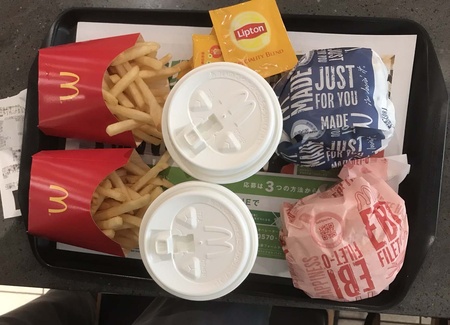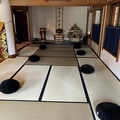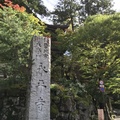As I strode down the station corridor past the ticket gates, I became nostalgic for my childhood in Southern California. It was dinner time, and in the four months I’d been in Japan I had tried nearly every bento type in the supermarket. I wanted to eat something different, and so suddenly I veered out from the flow of traffic and found myself standing under a large overhead menu. I studied it, sounding out the choices one katakana symbol at a time. Thank God for the photos! Big Mac. Quarter Pounder. Chicken McNuggets.
I dismissed these offerings. If I was going to take a break from my usual Japanese diet, I wanted to eat something that I couldn’t get back home. Shrimp burger was the answer—with large fries and a hot Lipton tea. Ok, I could get french fries in L.A.—anywhere, really. Drinking tea, however, had become de rigeur for me while living in Tokyo, although never Lipton.
As I reached the counter my smile dropped and breadth quickened. Chotto matte kudasai. The menu didn’t have numbered meal sets, so I couldn’t simply pronounce “Naamba fai-bu set-oo onegai shimasu.” I gathered myself and ordered à la carte while pointing to pictures of the chosen items.
That wasn’t too bad, but then the dreaded happened. The chirpy female clerk asked me a question. I expected her to repeat my order and announce the price to be paid. But she spoke, and I froze before my familiar only-in-Japan instinct kicked in. “HAI,” I said, and repeated it in response to her follow-up question, each time hunching my shoulders and slightly bowing my head.
This was a ritual for me in Japan. Do you need a bag for your item? HAI. This is a sushi bento you’re buying? HAI. Do you want a little ice pack to keep it cool for your trip home? HAI. This is a 10,000 yen bill you’re giving me? HAI.
When I picked up my order and saw two meal sets, I realized that this time “HAI” wasn’t the right answer.
How hungry did she think I was? I deduced that she must have said, “Why not supersize your order by adding another meal set exactly like it but with a filet-o-fish instead of a shrimp burger?”
I carried the tray with the twinned meal sets upstairs to the dining area and placed it on a table for two. I ruefully texted my friend Reina a photo of the loaded tray along with an explanation of what happened capped by embarrassment and WTF emojis. She replied immediately: a round yellow face laughing hysterically.
To be sure, Reina was interested in foreigner experiences in Japan, her home country; but could she possibly understand my plight as a fourth generation American “returning” to the motherland? I wasn’t sure. Afterall, she was equally at home on either side of the Pacific; and, as if to prove it, she was writing a memoir in both English and Japanese on opposite sides of the page.
Reina was born in New Haven and raised in Tokyo; she spent a few formative years in Chicago, then returned to Japan and graduated from a Japanese university. She completed a Ph.D. on the East Coast and now teaches in Oregon.
Compared to Reina, I was cemented to one side of the Pacific. Sure, I had taught classes and given talks at universities throughout Japan, but the thought of studying in Japanese—let alone completing a degree at one of these schools—never crossed my mind.
In Tokyo, I lived in an English-language bubble surrounded by friends, colleagues, students, and university staff who supported me by doing things like calling to check on a late pizza delivery that I ordered online in English. Inside the bubble, I enjoyed the status of a native English-speaking professor who was in Japan under the aegis of a government-sponsored scholarly exchange program. Outside the bubble, I faced a different and foreign world—the kind in which I ordered one meal set and received two.
To repeat, could a Japanese-American like Reina understand my predicament? Note the hyphen in “Japanese-American”; it says so much about the gap between her experience and my own.
When I identify as “Japanese American” (no hyphen), the emphasis is on American, since Japanese is the modifier. For Reina, the hyphen connotes a balance between the two sides; it’s an expression of her linguistic, cultural, professional, and personal transit back-and-forth between Japan and the US.
For Reina, the transpacific is like an East-West bullet-train—fast and easy with seats that turn around in either direction so you’re always facing forward. For me, the transpacific is a tour bus with an English-speaking guide, and I’m never sure which direction it’s going.
An even bigger difference between Reina and me has to do with race and minority status. Save for a few years in Chicago, she grew up in Japan surrounded by faces matching her own. Nor did she inherit from her parents the burden of being a stigmatized minority. Now had she been born into a Korean family in Japan, she might have understood my predicament; and, even more, had she been a fourth-generation Korean from Japan who was abroad in Seoul trying to order beef bowl at Yoshinoya, she might have known exactly how I felt at MacDonalds. Well, maybe not exactly since Koreans in Japan can pass as Japanese if they choose to do so.
Gochisousama deshita.
My meal finished, I stared at what remained of the two meal sets. I had managed to eat the shrimp burger along with the unexpected filet-o-fish. I also gobbled down one of the two sleeves of fries and drank one of the two Lipton teas.
I wrapped the uneaten sleeve of fries with my unused second napkin and inserted the package carefully into my backpack, along with the unopened Lipton tea bag—which I knew I wouldn’t use but couldn’t bear to throw away. Mottainai. I placed the tray on the return rack and poured the second cup of still hot water into the receptacle for liquid waste, sorting the wrappers, cups, used napkin, and opened and twisted ketchup foils into the proper bins for recycling and burnable waste.
I decided to walk home from the station instead of riding the local train two stops through the western suburbs. Maybe I could work off some of that second sandwich?
My encounter at McDonalds—one of countless gaijin blunders I committed while living abroad—goes a long way towards explaining why I was in Tokyo. As part of my country’s efforts to win the hearts and minds of peoples around the world, the fellowship I was on is designed to bring American professors abroad to teach various classes about the United States. Most importantly, the classes are to be taught in English and visiting lecturers never have to speak the local language. As a result, most of them are white, save for a handful of persons of color like me who grew up speaking English only. That my family has lived on American soil for over one hundred years explains my monolingualism.
But I wasn’t a Japanese language virgin. Two years of college classes, as well as self-study I engaged in just before coming to Tokyo, enabled me to ask simple questions like “What is this?” “What time is it?” and “Where’s the bathroom?” I might have even understood the McDonald’s clerk’s questions had she repeated them slowly while I looked up words and phrases on my dictionary app. But no way was I going to ask her to do that.
In Tokyo, I was an adult who read and spoke like a six-year old. Did I want to be fluent in Japanese? You bet. I regretted having been uprooted from my ancestral language, heritage, and homeland. This regret began during college when I was enrolled in first-year Japanese.
During graduate school, after I became aware of the mass incarceration of Japanese Americans and was conducting historical research of my own to right past wrongs, my interest in my ancestry transmogrified into righteous outrage. Why had my heritage been stolen from me? Why and how was I tricked into defending the supreme value of whiteness and Americanism even though I wasn’t allowed to claim them in my own country?
So was it that my ancestral heritage became politicized. I rejected Americanism as a vehicle of whiteness and instead embraced Japan as a crucial (though largely unknown and undeveloped) part of me. This explains why, three decades later when living in Tokyo, I shunned McDonalds until that moment in the station when I gave in to a sudden craving. Such a disregard had little to do with healthy eating; I had no problem frequenting Mos Burger and other Japanese fast-food joints.
Rather, while in Tokyo I went out of my way to conform to Japanese values, norms, and customs so as to reclaim my birthright. Never mind that the values, norms, and customs I absorbed and performed were not necessarily the same as those that my grandparents and great-grandparents had brought with them to the US.
Many foreigners in Japan adopt stereotypical Japanese characteristics, such as incessantly bowing and saying sumimasen and being hyper-vigilant about separating and washing their trash. The obsession with fitting in is part of the gaijin experience everywhere. When in Rome do as the Romans do. I didn’t know any foreigners in Japan who fit the stereotype of “ugly Americans.”
But race set me apart from them. Even African Americans and Latinx persons, who experienced their own racial traumas back home, couldn’t share my predicament. If I kept my mouth shut, Japan offered me, but not these other gaijin, a chance to escape being an outsider.
In Japan, I didn’t stand out as a potential enemy, as at home: The Jap, The Chink, The Gook. Nor did I need to negotiate a forest of racially coded symbols, which on L.A. Metro meant wondering who to sit next to, who should sit next to me, and whether to sit down at all or move to the next car. In Tokyo, I was free from the weight of such conscious and semi-conscious choices. On trains and subways, I occupied any and every available space. There was no need to scan for potential threats to my body or self-esteem. My racial radar became de-activated.
Ever since elementary school, I have been trying to escape racism. These efforts can be broken down into three types. The first is assimilation—that is, trying to blend in as white and deny or cover my racial difference. Second, as mentioned, is rejecting whiteness in favor of embracing my ancestry and “authentic” ethnic self. Third, most recently, is leaving home and seeking solace in Japan.
Now you know the real reason why I was in Tokyo. The visiting lectureship program was simply the means to achieve my goal—to escape having to escape from racism. This meant finding a permanent job and new life partner, while spending the rest of my days happily passing as Japanese.
As a historian of Asian immigration, I recognized the irony. Rather than set out as a young person to make a name for myself in what early Japanese immigrants called Beikoku (North America), I headed to Japan in middle age to be released from the striving for status and success, including struggling to hold on to whatever status and success I had already achieved. Rather than seek happiness, I just wanted to be happy. This was part of my reverse American Dream.
*The above essay is excerpted from the memoir he is currently writing, “Home Leaver: A Japanese American Journey in Japan.”
© 2023 Lon Kurashige







